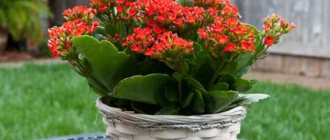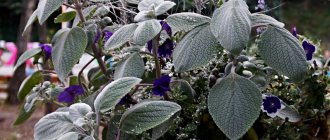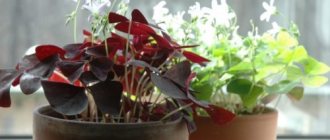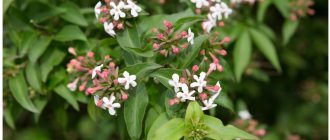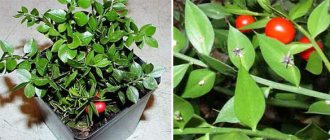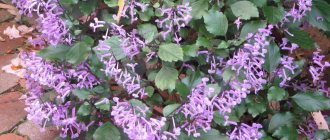Palms are an ancient family of plants. Its different species have taken root in the tropics, subtropics and equatorial forests. These are coconut, oilseed, peach, ginger, date and other palm trees. Among the fruits that grow on them are coconuts, dates, drupes, and saw palmetto. In total, there are more than 3,000 individual varieties in the family. You can find a detailed description of each. Palm trees are the most recognizable plants in the world, despite the fact that their habitat can be limited not only to warm regions, but also to several islands. They are well adapted to the wild and outperform many plants. One of the amazing properties of palm trees is their endurance in unusual conditions. Some subspecies easily withstand severe frosts and other unfavorable factors. Palm trees can grow indoors in different climates and do not require careful care. You can grow them without gardening experience.
Benefits of decorating the interior with palm trees
Beautiful appearance is the main quality of an ornamental palm tree. It is characterized by a variety of sizes and shapes. These plants come in both fast and slow growing varieties. The slow ripening speed makes it possible to grow a large palm tree at home for some time, and before it reaches the size usual for the natural environment, plant it in another place. The rate of development additionally depends on care and the amount of sunlight received. Each individual subspecies has some abilities, which simplifies the choice for those who want to purchase this plant. You can choose a beautiful palm tree that is undemanding to external conditions: smooth or prickly, fast-growing if you need a large plant in a short time, or slow-growing if the priority is the long-term presence of the palm in the interior. Some dwarf species are bred by humans.
Indoor and decorative
Palm trees in a room are not only exotic, greetings from the tropical forest, they are an important detail of the interior, often capable of changing it dramatically. However, not all palm trees are suitable for growing indoors.
Here are some particularly interesting varieties.
Dates . The most common, there are more than 17 species of such palms, they grow wild in Asia and Africa. And if you plant a seed from an ordinary date, it will sprout. Their germination rate is almost one hundred percent, but they will germinate for about a month. Such a tree will become decorative in five years. It is better to buy Date palmate . This species does not grow in the wild. Indoors it grows up to 6 meters. True, this takes more than one decade.
A very ornamental plant is the Robelena date ; its fruits are not edible. The palm tree has a crown with leaves gracefully curved downwards and an original, shaggy trunk.
Date Robelena
Areca Chrysalidocarpus , which grows naturally in the forests of India, is grown indoors Its crown is a huge bunch of meter-long leaves at the top of the trunk, covered with a large number of scars arranged in rings.
The bottle-shaped trunk and leaves look original - the fans of Trachycarpus . It is ideally suited for growing indoors. Trachycarpus flowers and bears fruit. There are two types: Martius and Fortune.
See also: 5 unusual structures in giant trees
It grows fastest in Kariota . It is noticeably different from other such plants. The fronds resemble a triangle extended upward. Kariota lives only 20 years.
Washingtonia is an ornamental palm tree with a crown in the form of a bright green huge fan. Caring for it requires certain knowledge.
Washingtonia filamentosa
The hardest tree to grow indoors is the coconut tree. It requires a lot of light and is more suitable for winter gardens. There are mainly two types of coconut grown in the room: nuciferous coconut and Weddel coconut.
Ideal for growing indoors Hamedoreas , especially Hamedoreas are graceful, monochromatic, tall and oblong.
Liviston palms have been grown indoors for centuries. They are very decorative, but they require special conditions to grow successfully.
Rapis is an unpretentious, slow-growing bushy plant with soft, dark green leaves. Simply ideal for rooms. Easily tolerates all inconveniences: poor lighting, dry air, drafts.
Another feathery palm with soft leaves is Govea , or Kentia, a popular plant, very decorative.
Hamerops are widespread indoor plants, unpretentious and very decorative, growing slowly. The trunk gradually becomes overgrown with brown fibers, the leaves are pinnate with spines.
Hamerops
One of the most capricious is Butia . But if you find an approach to it, it will delight you with its surprisingly graceful crown of feathery leaves.
Rare Giophorba . It is small, with fan-shaped foxes and a trunk that resembles a bottle at the bottom.
Sabal is another rarity from the American subtropics. Low, bluish-green leaves, growing on short petioles.
Betel nut - only passionate palm lovers know about it; it is distinguished by its lush crown and beautiful small trunk. In nature, it grows up to 20 meters in height and has two-meter leaves. In indoor conditions it grows for a long time and has a much more modest size.
Betel palm
Rules of care
The best place to grow palm species is a greenhouse. Palm trees located in such a room receive a lot of diffused sunlight from different directions. Their appearance will be better than in an ordinary room. But due to the unpretentiousness of these plants, creating similar conditions in an apartment or house will give the same result. First of all, you need to look at the condition of the leaf blades. If their appearance has changed, then this most likely indicates a deterioration in the health of the palm tree. At home, their leaves may fall off and grow back. In a year, up to three leaves can grow, but more than four can fall off. Thus, the palm tree may be left without leaves and die. Some species, starting from a certain time, are generally unable to grow it. Do not confuse the natural process of shedding leaves due to palm growth and the disease due to insufficient care.
To avoid misunderstandings and properly care for your palm tree, you need to listen to the opinions of experienced gardeners.
Illumination
Only some ornamental palms are recommended to be placed in the sun. Typically they should be kept away from direct light. From an excess of light, the condition of the plant can deteriorate sharply. This factor also provokes rapid growth, which may lead to the fact that the palm tree will have to be moved to another place. Ideally, plants should receive diffused light. Only a few palms are shade tolerant. If the plant is moved outdoors, then you need to choose a place where it is constantly in partial shade. Since most palm trees are light-loving, it is better to place them on the sides of the window, reliably protecting the top of the crown from direct rays. Before choosing a place for the pot, you need to find out which side the windows face. It is not recommended to place palm trees on the south, southwest and southeast sides. This recommendation does not apply to the most light-loving palm trees.
Temperature
Despite the fact that in their natural habitat palm trees grow at high temperatures in summer and in cool/hot climates in winter, home care requires keeping them at temperatures no higher than +25 °C. The reason is that even in nature, palm trees tend to be protected from the sun. In summer, plants should be in a warmer environment, and in winter they should be moved to a cool place (verandas, courtyards). Heat-loving palm trees should winter at +13...+16 °C, and frost-resistant palms should winter at temperatures from +8 °C to +11 °C. Do not forget about the relationship between temperature and air humidity. A room with high humidity will increase the feeling of warmth and the feeling of coolness, depending on the temperature. If the room, on the contrary, is too dry, then these conditions will be perceived in the same way.
Humidity and watering
Palms are hydrophilic plants. Their location in the natural environment directly depends on the presence of a source of moisture. But almost all species, including palm trees, growing in dry areas of the Earth can survive for a long time without water. For full development, you need to keep the humidity at 70% or higher, as far as the type of room allows. You can place a container of water near the plant. Palm trees should be watered carefully so as not to cause deterioration of the roots. In summer, watering should be more abundant and more frequent, especially in hot weather. In winter, the soil should be kept slightly moist, but not wet. If there is a lot of water in the ground or it forms accumulations, the condition of the palm tree can deteriorate sharply. It is necessary to water your plants with good quality water, but doing so with distilled water can be dangerous. It is recommended to keep the leaves of some species dry and wipe them as rarely as possible. For irrigation you need cool water with a temperature of at least +20 °C.
Common types of palm trees: detailed description, name and photo
About 20 species of palm trees are now grown in indoor floriculture. These plants are becoming increasingly popular. Their decorative qualities are highly valued.
Indeed, palm trees look unusual against the backdrop of snowdrifts outside the window; they have an interesting shape of leaves and trunks.
In addition, some of them can grow in partial shade, this allows you to create interesting corners in the apartment, the center of which is a palm tree.
With their help, verandas and loggias are landscaped. Even in places with harsh winters, they become an integral part of the garden in the summer; they are taken there directly in tubs.
You will learn about what types of indoor palm trees there are, their names and photos, as well as what the generic name of the plants of the family is in this article.
See also: High-altitude photographs will take your breath away
How to grow your own
You can also propagate palm trees at home. Ornamental palms need to be grown by sowing fresh seeds, and in some cases, by cuttings. Germination requires a temperature of +25…+35 °C. They are sown in pots with sawdust, moss and sand. A drainage layer with charcoal particles is placed at the bottom. Seeds germinate within a week or several months (depending on the species). It is necessary to replant before the start of active growth, in the spring. Young palm trees need to be transhipped every year, old ones - once every few years. During these manipulations, you should be careful with the roots. The pot should be selected based on the size and shape of the rhizome. If the roots rise from the ground, then you should choose a high pot. For accelerated development in spring and summer, it is recommended to use fertilizing in the form of organic fertilizers.
Most palm trees do not tolerate the replanting process well, so it needs to be done quickly and as rarely as possible.
Not grown indoors
Many remain unknown in indoor floriculture for many reasons. Most often due to its gigantic size or growth characteristics.
- The oil palm grows in Africa, reaches 30 meters in height, and sheds its leaves every two years.
- Saw palmetto grows in the southern United States and on islands in the Caribbean. This palm tree grows very slowly and most often reaches no more than 2-4 meters, its flowers have a fragrant scent.
- Carnauba or waxy, grows in South America, has fanned leaves forming a lush ball. Several species are known.
- Bismarckia grows in Madagascar and has silver leaves.
- Pandanus or screw palm. The leaves on its trunk are arranged in several rows in the form of a spiral.
- Calamus or rattan is the longest plant in the world, the leaves of which grow from buds on the trunk. Easily clings to trees with the help of thorns at the end of the leaves.
See also: One frame: photographs from the magazine “Around the World”
Bismarckia
Oilseed
Serenoa
Carnauba
Calamus
Garden
This concept is very conditional, since almost all palm trees can grow in winter gardens and in open plantings, if the climate is favorable for this. There may be restrictions only because of the size of the tree, the minimum temperature it can tolerate, and the ability to provide good shelter for the winter.
Many scientists are working on developing frost-resistant palm species, because this is a very interesting decorative material for landscape design.
Most often, frost-resistant ones are planted in gardens. Most often these are Trachycarpus and, in places with warm climates, Bismarckia.
Trachycarpus
Not blooming
There are 50 species of non-flowering palms. They usually reproduce by spores or vegetatively. Almost everything in the rooms does not bloom.
Frost-resistant
There are few palm trees that can withstand frost. These are heat-loving plants by origin. But still there are some.
Let's take a closer look at these varieties with photos and names.
- Brachea is one of the favorite gardeners to grow at home. Grows quickly. It has fan-shaped, lush green leaves. It is easy to care for and can withstand temperatures down to -8 degrees.
- Trachycarpus is one of the most frost-resistant, can withstand short-term frosts down to -23 degrees and permanent frosts down to -10.
- Wshingtonia filamentous - can grow in cold, unheated rooms and tolerate temperatures dropping to -5-8 degrees.
- Sabal - different species tolerate frost from - 10 to - 20 degrees.
- Butia - can withstand temperatures down to -12. At a frost of -14, the leaves freeze, but it does not die.
Dwarf sabal
Palm trees came into rooms a long time ago, from the times when they decorated galleries and state rooms of palaces. And now a large well-groomed palm tree is a source of pride for its owner. It radically changes the interior of the room and creates a completely different, somewhat unusual and very cozy space. It is believed that it gives its owner health and longevity.
source
If you find an error, please select a piece of text and press Ctrl+Enter.
What plants are palm trees?
Palmaceae (Arecaceae) are a family of plants with a woody stem (trunk) and long, broad, feathery leaves growing straight from the trunk. Palm trees bear fruit. The most famous fruit tree of this family is the coconut.
REFERENCE. Plants of this family have straight, columnar, non-branching trunks. And the leaves begin to grow almost at the very top of the head.
Trees are distributed throughout the Tropical and Subtropical zones. In Russia, varieties of these plants can be found on the Black Sea coast of the Krasnodar Territory. In areas of natural growth, trees are used in industry and grown in agriculture.
Some varieties of palm trees are cultivated as indoor decorative foliage plants. Their only difference from their “wild” counterparts is their short stature and rare fruiting.


